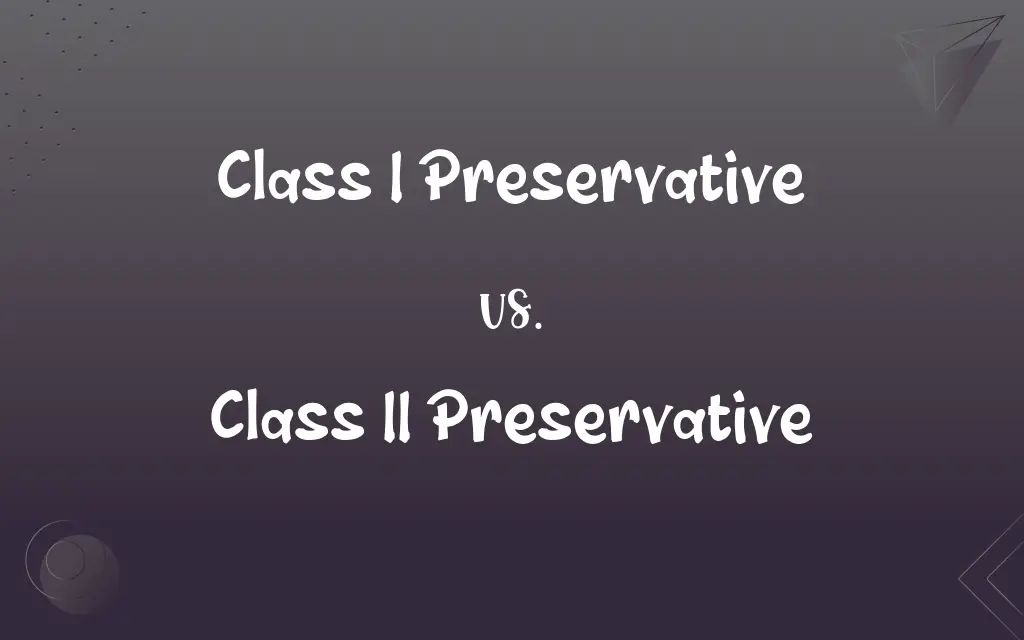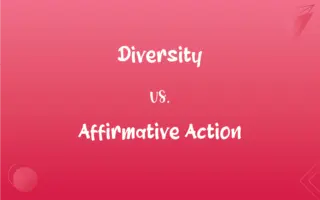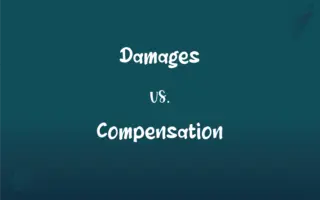Class I Preservative vs. Class II Preservative: What's the Difference?
Edited by Aimie Carlson || By Janet White || Published on February 1, 2024
Class I preservatives are naturally occurring substances, often used in their natural form, while Class II preservatives are synthetic and chemically manufactured to preserve food.

Key Differences
Class I preservatives include naturally sourced substances like salt, sugar, and vinegar, used in their unaltered form to prolong the shelf life of food products. In contrast, Class II preservatives are synthesized chemicals like benzoates, sulfites, and nitrates, specifically created to prevent spoilage and extend food freshness.
The application of Class I preservatives often involves traditional preservation methods, such as pickling, curing, or drying. Conversely, Class II preservatives are added to products during processing to inhibit microbial growth and oxidation.
Class I preservatives are generally considered safer and more consumer-friendly due to their natural origin. On the other hand, Class II preservatives, being synthetic, can sometimes cause allergies or other adverse reactions in sensitive individuals.
Class I preservatives also serve to enhance flavor, texture, or appearance, while Class II preservatives are primarily focused on extending shelf life and maintaining food quality during storage and distribution.
Both Class I and Class II preservatives are essential in the food industry, with Class I being favored for organic or natural products, and Class II being more common in processed and packaged foods.
ADVERTISEMENT
Comparison Chart
Origin
Naturally occurring substances
Synthetically manufactured chemicals
Application Methods
Traditional methods like curing, pickling
Added during food processing
Consumer Perception
Generally considered safer
Can sometimes cause allergies or reactions
Primary Purpose
Flavor enhancement and preservation
Extending shelf life, inhibiting spoilage
Usage in Food Products
Common in organic/natural products
Prevalent in processed/packaged foods
ADVERTISEMENT
Class I Preservative and Class II Preservative Definitions
Class I Preservative
Common in organic and natural food products.
Honey is a popular Class I preservative in natural baking.
Class II Preservative
Synthetic chemicals added to food to prevent spoilage.
Sodium benzoate, a Class II preservative, is used in soft drinks.
Class I Preservative
Used in traditional food preservation methods.
Sugar, as a Class I preservative, is crucial in jam making.
Class II Preservative
Often found in packaged and convenience foods.
Class II preservatives are common in ready-to-eat meals for longer shelf life.
Class I Preservative
Regarded as safer due to natural origin.
I prefer Class I preservatives like salt for homemade foods due to their safety.
Class II Preservative
Extends the shelf life of processed foods.
Class II preservatives like sulfites help maintain freshness in packaged foods.
Class I Preservative
Naturally occurring substances used for food preservation.
Salt, a Class I preservative, is used in curing meats.
Class II Preservative
Can sometimes cause adverse reactions.
People with allergies need to check for Class II preservatives on food labels.
Class I Preservative
Enhances flavor while extending shelf life.
Vinegar, a Class I preservative, gives pickles their distinct taste.
Class II Preservative
Used for inhibiting microbial growth.
Nitrates, as Class II preservatives, are used in processed meats to inhibit bacterial growth.
FAQs
How are Class I preservatives used?
Through traditional methods like pickling, curing, and drying.
What are examples of Class II preservatives?
Synthetic chemicals like sodium benzoate, sulfites, and nitrates.
Do Class I preservatives enhance food flavor?
Yes, they can also enhance flavor and texture.
What are Class I preservatives?
Naturally occurring substances used in food preservation.
Can Class II preservatives cause allergies?
Yes, they can sometimes cause allergies or adverse reactions.
Are Class I preservatives considered safe?
Generally, they are safer due to their natural origin.
Can I find Class I preservatives in homemade food?
Yes, they are commonly used in homemade preserves and cured foods.
Why are Class II preservatives added to food?
To extend shelf life and prevent microbial spoilage.
Are Class II preservatives synthetic?
Yes, they are chemically manufactured.
Are nitrates in processed meats Class II preservatives?
Yes, nitrates are common Class II preservatives in processed meats.
What is the primary purpose of Class II preservatives?
To inhibit spoilage and extend the product's shelf life.
Do Class I preservatives have a long history of use?
Yes, they have been used traditionally for centuries.
Can Class I preservatives be used in organic food production?
Yes, they are often preferred in organic food processing.
What foods typically contain Class I preservatives?
Organic and natural products often use Class I preservatives.
Are Class II preservatives found in natural foods?
No, they are more common in processed and packaged foods.
Do Class II preservatives affect food taste?
They are used more for preservation than taste enhancement.
Is salt considered a Class I preservative?
Yes, salt is a traditional preservative used in curing.
Do Class II preservatives require careful labeling?
Yes, due to potential allergies, their presence must be clearly labeled.
Is vinegar a Class I preservative?
Yes, vinegar is a natural preservative used in pickling.
Are sulfites Class II preservatives?
Yes, sulfites are synthetic preservatives in many processed foods.
About Author
Written by
Janet WhiteJanet White has been an esteemed writer and blogger for Difference Wiki. Holding a Master's degree in Science and Medical Journalism from the prestigious Boston University, she has consistently demonstrated her expertise and passion for her field. When she's not immersed in her work, Janet relishes her time exercising, delving into a good book, and cherishing moments with friends and family.
Edited by
Aimie CarlsonAimie Carlson, holding a master's degree in English literature, is a fervent English language enthusiast. She lends her writing talents to Difference Wiki, a prominent website that specializes in comparisons, offering readers insightful analyses that both captivate and inform.































































